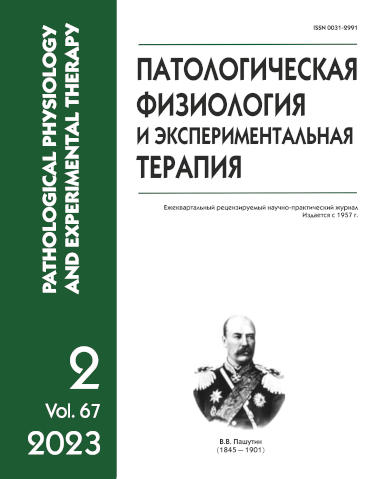Changes in the ratio of free factors of neohemangio- and neolymphangiogenesis as a pathogenetic mechanism for melanoma B₁₆/F₁₀ superaggression in a model of chronic neuropathic pain
Abstract
Introduction. In oncology, the appearance and severity of neuropathic pain is associated with primary tumor growth, intensity of metastasis, and side effects of drug therapy and other types of treatment. Intensive chronic pain syndrome impairs quality of life, may result in dose reduction or treatment termination, and may also cause activation of tumor growth and dissemination. Neoangiogenesis, the growth of new blood and lymphatic vessels, is a complex, multi-stage and conjugate process that involves several growth factors. This process is essential for malignant tumor growth and metastasis. Among growth factors, the most important ones are the vascular endothelial growth factor (VEGF) family. The aim of the study was to evaluate the effect of chronic neuropathic pain on the level of free growth factors of the VEGF family and their ratio in the intact skin of C57BL/6 mice in the phase of active dissemination of melanoma B16/F10. Methods. Experiments were performed on C57BL/6 female mice. The В16/F10 melanoma cell line metastasizing to the lungs was used (subcutaneous grafting). Neuropathic pain was modeled by ligation of sciatic nerves using a method modified by the authors. The animals were divided into groups: two control groups, intact mice and mice with modeled chronic pain; a comparison group, mice with standard subcutaneous grafting of melanoma В16/F10; and a main group, mice with melanoma В16/F10 transplanted at 2 weeks after modeling chronic pain. The skin not affected by the malignant process was collected on ice after euthanasia. Concentrations of VEGF-A, VEGF-C, VEGFR-1, and VEGFR-3 were determined in tissues using standard ELISA test systems. Concentrations of free factors of the VEGF family were determined as a concentration ratio of the growth factor to the respective receptor. Results. The growth of melanoma В16/F10 in combination with chronic pain was associated with increases in free VEGF-A and VEGF-C (7 and 19 times, respectively). Processes of blood vessel formation predominated in intact animals and animals with tumor alone (ratio factors 178 and 172, respectively). Chronic pain alone and in combination with tumor was associated with increased formation of lymphatic vessels (ratio factors 4.3 and 64, respectively). Conclusion. Modeling of chronic pain syndrome induced activation of hemangio- and lymphangiogenesis factors both in the skin of intact animals and animals with transplanted melanoma В16/F10. Predominant activation of neolymphangiogenesis may be the main component in the pathogenesis of melanoma В16/F10 superaggression in the presence of persistent chronic pain.






